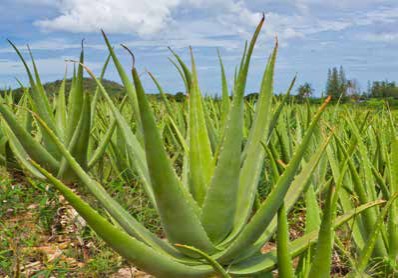Aloe Vera, a specie protected by CITES

The Convention on International Trade in Endangered Species of Wild Fauna and Flora (CITES), signed in 1973, aims to ensure that international trade in specimens of wild animals and plants does not threaten their survival. It accords varying degrees of protection to more than 30 000 species of animals and plants. CITES works by making international trade in specimens of selected species subject to certain controls. These include a licensing system that requires the authorization of the import and (re-)export of species covered by the Convention. The species covered by CITES are listed in three Appendices, granting varying degrees of protection to them.
How CITES works?
CITES works by subjecting international trade in specimens of selected species to certain controls. All import, export, re-export and introduction from the sea of species covered by the Convention has to be authorized through a licensing system. Each Party to the Convention must designate one or more Management Authorities in charge of administering that licensing system and one or more Scientific Authorities to advise them on the effects of trade on the status of the species. The species covered by CITES are listed in three Appendices, according to the degree of protection they need.
Revised Nomenclature for Aloe
The genus Aloe L. comprises +575 species of leaf-succulents native to the flora of the African continent, the Arabian Peninsula, Socotra Island, and Madagascar, as well as the Seychelles, Mascarene and Comoros islands in the Indian Ocean. Several Aloe species occur in the invasive or naturalised flora of the Mediterranean, India, parts of North and South America, the Caribbean and Australia. Like many succulent plants, aloes are collected by enthusiasts and extensively used and traded in horticulture. Unusual and rare species, such as the endemic Madagascan species of Aloe, are particularly valuable. Aloes are culturally important throughout their range. Concerns for their conservation are reflected by local and international protection afforded them.
Aloe (Except the species included in Appendix I. Also excludes Aloe vera, also referenced as Aloe barbadensis which is not included in the Appendices)
All parts and derivatives, except: a) seeds (including seedpods of Orchidaceae), spores and pollen (including pollinia). The exemption does not apply to seeds from Cactaceae spp. exported from Mexico, and to seeds from Beccariophoenix madagascariensis and Neodypsis decaryi exported from Madagascar; b) seedling or tissue cultures obtained in vitro, in solid or liquid media, transported in sterile containers; c) cut flowers of artificially propagated plants; d) fruits, and parts and derivatives thereof, of naturalized or artificially propagated plants of the genus Vanilla (Orchidaceae) and of the family Cactaceae; e) stems, flowers, and parts and derivatives thereof, of naturalized or artificially propagated plants of the genera Opuntia subgenus Opuntia and Selenicereus (Cactaceae); and f) finished products of Euphorbia antisyphilitica packaged and ready for retail trade.
A single species, Aloe vera, is excluded from the CITES Appendices because it is cultivated as a commercial natural product crop and is not known in the wild. There is therefore no perceived risk to the species due to trade.
The proposed amendment to exclude finished products of Aloe from regulation under CITES will facilitate the in-country processing of both primary and secondary extracts from leaf material, thereby promoting the sustainable and efficient use of wild harvested aloe resources whilst simultaneously enhancing benefits to community livelihoods and local economies. The annotation will not hinder effective regulation of the species as the major commodities that dominate the trade and the demand from the wild resource (i.e. raw A. ferox extracts) will remain under strict control.
Latest News

Aloe Vera Compounds
AMB WELLNESS offers active & excipient Aloe Vera Ingredients with key points of value for Nutra & pharma applications. Aloe Vera is an excellent carrier and excipient for food supplements, sport nutrition, food fortification, fortified premixes, nutraceuticals & animal health. Aloe Vera is an ingredient that will surely be of the interest for companies manufacturing tablets, softgels, hard capsules, powders and functional drinks.

Aloe vera delivery system for dietary supplements
Cosmeceuticals combine the best of both worlds: wellness and beauty. At this intersection, marketers are seeking to help define the term cosmeceutical; this term tends to imply a
product that is neither a drug, nor a cosmetic, but one that has a desired impact inside the skin. To product developers, it has come to mean any nutritional supplement that demonstrably improves health and beauty, with a particular focus on skin health. A cosmeceutical is a product or formula that contains an important nutritional component such as an herb, mineral or functional dietary nutrient that is ingested for the specific health benefits and appearance of the consumer.

Aloe Vera and the Cosmeceuticals
Aloe Vera is packed with vitamins, minerals, polysaccharides, phytosterols, antioxidants, and amino acids, this one plant is as effective for internal concerns as external ones, as relevant to the athlete as to the aging adult, and as popular for looking better as for feeling better.
Aloe Vera is extremely nutritious and safe to eat and eventually consumption as a beverage or juice or externally in hair or body.

